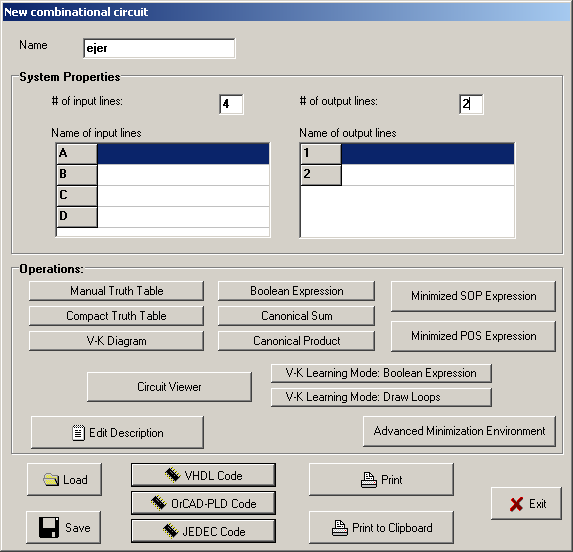Boole-Deusto is available for download here. The latest version is BooleDeusto Jan. 2014 (English)
Boole-Deusto is Open Source. Traditionally it has been hosted in SourceForge, but for the latest versions we have moved to a GitHub repository.
Boole-Deusto is an educational software tool for Digital Electronics. Digital electronic circuits can be classified in two large groups: combinational and sequential circuits, depending on whether they have a memory (and are hence sequential) or not. Boole-Deusto supports both types, as long as they are bit-level.
Unlike other, sometimes more advanced tools, Boole-Deusto is especially oriented for students. Focusing on the design process, students can use Boole-Deusto through every step in a digital circuit's design, getting involved only to the extent they (or their teacher) desires. That is, it can be used to generate a circuit straightaway, or it can walk through every step involved (such as Karnaugh Maps and logic simplification).

Boole-Deusto is distributed as a compressed executable, with no dependencies. Thus, no installation is really required. You can simply:
boole.exe.Boole-Deusto can be used to design, implement and test (through the Weblab Remote Laboratory) logical systems. It mainly supports two types of systems:
Though Boole-Deusto offers many tools for each kind of system, the basics are relatively straightforward. Here we will describe, as an example, the steps that you need to follow to design, implement and test a basic combinational system.
Note: Before you start, write a problem statement or a definition of your system. It is advisable to have a clear idea of what you want your system to accomplish before getting started.
Note: The workflow that has been described here the simplest possible. Many intermediate steps, such as boolean expression simplifications, are here carried out by Boole-Deusto itself. This, however, is somewhat contrary the point of the tool. Many users will want to carry out these steps themselves through the use of tools such as the Karnaugh diagrams, which are also supported.
Note: For testing with Weblab-Deusto, you may require certain Weblab-Deusto privileges. If access to the FPGA experiment is not available, please ask the administrators.
Weblab-Deusto is a remote laboratory which offers access to many remote experiments. Among those experiments we have:
Boole-Deusto integrates closely with these, and is able to generate VHDL code that is immediately compatible with Weblab and with those laboratories. To do so:
In the 1990s, there were already several powerful professional analysis and design tools available. Unfortunately, these didn't really suit our academic needs because they were not really oriented to an educative settings. Also, though a few tools had been developed specifically for the classroom, these didn't meet our expectations either. What this means is, essentially, that Boole-Deusto isn't meant to replace Electronics WorkBench, Xilinx's ISE or Or-CAD, etc. Its purpose is quite different: to make life easier for students and teachers of digital electronics.
With this in mind, we decided to restrict BOOLE to bit-level combinational systems and finite-state machines, choosing not to include word-level circuits (adders, codifiers, counters, etc.) since those are covered adequately by (for example) EWB. Furthermore, since we also set out to use BOOLE in first-year logic design courses, the exercises would naturally would be simple and small, so bit-level circuits would be enough for our needs. Although we have used BOOLE with very complex circuits, it is not its intended use, and we advise against using it for professional purposes.
In general, BOOLE is a didactic software package, focused on the methodology of the exercises, easy to install, easy to use, graphical, and available in several languages: English, Spanish, and Basque. “Ease of use” is the key concept in BOOLE, so we hope many users will be relieved to see that installation is painless and that the user manual is not 400 pages long.
Originally, Boole-Deusto was developed as a stand-alone package. Now, however, though it can still be used stand-alone, its features have been extended with WebLab-Deusto (Remote Laboratory) integration. The system as a whole can provide a more comprehensive learning experience for the student, who can, in just a few minutes, design a digital system and test in a real hardware, requiring only Boole-Deusto and a Web browser.